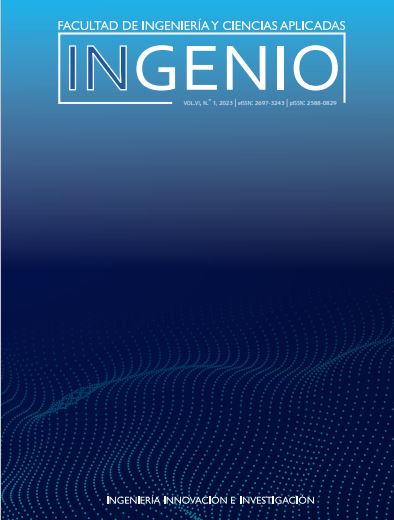Comparative Analysis of the Life Cycle - Carbon Footprint of a Reinforced Concrete Building Compared to a Metal Structure Building
Main Article Content
Abstract
The research project is aimed at carrying out a comparative analysis of the carbon footprint generated in a reinforced concrete building against the carbon footprint of structural steel building, applied to a building 4 stories high which is made up of porticoed structural elements. Towhich end, the life cycle assessment (LCA) methodology was applied, a methodology that systematically describes the process for quantifying the carbon footprint, by assessing the contribution of greenhouse gas (GHG) emissions in terms of tons of carbon dioxide equivalent (t CO 2 eq) for each stage of the life cycle of the buildings subject to study and a useful life period of 50 years. The applied life cycle analysis employed a product approach with a cradle-to-cradle scope of study, resulting in a carbon footprint for the reinforced concrete structural system of 724.71 (t CO2 eq) and for the steel structural system 440.93 (tCO2 eq), denoting that the greenhouse gas (GHG) emissions for the reinforced concrete structure is 64.36% higher than that of structural steel.
Additionally, as complementary data to the research, the environmental cost calculated according to the carbon footprint obtained for each structural system was determined, by applying the cost at which the emissions of (CO2) are quoted in the market to the current date, this being 65.22 €/tCO2 and knowing that this value could increase over time due to the high CO2 emissions generated by developed countries.
Downloads
Metrics
Article Details

This work is licensed under a Creative Commons Attribution-NonCommercial-NoDerivatives 4.0 International License.
References
W. K. Biswas, «Carbon footprint and embodied energy consumption assessment of building construction works in Western Australia,» International journal of sustainable built environment, vol. 3, pp. 179-186, 2014.
UNE ISO 14067, , Gases de efecto invernadero — Huella de carbono de productos — Requisitos y directrices para cuantificación, Suiza, 2019.
S. Alvarez, A. Rubio, A. Rodrígue y C. Avilés, Conceptos Básicos de la huella de carbono, Genova: AENOR Internacional, S.A.U., 2021.
UNFCCC, CONVENCION MARCO DE LAS NACIONES UNIDAS SOBRE, Nueva York: ONU, 1992, p. 26.
CMNUCC, «Convención Marco de las Naciones Unidas sobre el Cambio Climático,» 1992. [En línea]. Available: https://cambioclimatico.gob.mx/convencion-marco-de-las-naciones-unidas-sobre-el-cambio-climatico/.
UN, «Objetivos de Desarrollo Sostenible,» [En línea]. Available: https://www.un.org/sustainabledevelopment/es/cities/.
IDS , «Gases y efecto invernadero,» Madrid, 2018.
S. Alvarez Gallego, La huella de carbono de los productos, MAdrid: AENOR Internacional, 2021.
IPCC, «Our Word in Data,» 2014. [En línea]. Available: https://ourworldindata.org/grapher/global-warming-potential-of-greenhouse-gases-over-100-year-timescale-gwp.
V. Pardo, Artist, ANÁLISIS COMPARATIVO DEL CICLO DE VIDA - HUELLA DE CARBONO DE UNA EDIFICACIÓN DE HORMIGÓN ARMADO FRENTE A UNA EDIFICACIÓN DE ESTRUCTURA METÁLICA. (Tesis de Pregrado, Universidad Central del Ecuador). [Art]. Repositorio Institucional, 2022.
WBSCD & WRI, «Protocolo de Gases de Efecto Invernadero (GHG),» Septiembre 2005. [En línea]. Available: https://www.academia.edu/36429263/GHG_Protocol_Espa%C3%B1ol.
Worldsteel Association, «STEEL - THE PERMANENT MATERIAL IN THE CIRCULAR ECONOMY,» 2021. [En línea]. Available: https://worldsteel.org/circulareconomy/.
AISI, «BuildusingsteeL,» 2020. [En línea]. Available: https://www.steel.org/wp-content/uploads/2020/09/Steel-Sustainability-in-Steelmaking-Fact-Sheet.pdf.
R. Martínez, Artist, MÉTODO DE CÁLCULO DE HUELLA DE CARBONO EN EDIFICACIÓN, BASADO EN EL ANÁLISIS DE LOS ELEMENTOS BÁSICOS DESCOMPUESTOS DE LAS UNIDADES DE OBRA DEL PRESUPUESTO DEL PROYECTO DE EJECUCIÓN.. [Art]. UNIVERSIDAD CATÓLICA “SANTA TERESA DE JESÚS DE ÁVILA”, 2015.
Investing, «Investing.com,» 2022. [En línea]. Available: https://es.investing.com/commodities/carbon-emissions.
IDIEM & CDT, «ECOBASE CONSTRUCCIÓN,» Santiago de Chile, 2014.
A. GlobalEPD y IECA, «The International EPD® System,» 2021. [En línea]. Available: https://www.environdec.com/library.
D. Petroche y A. Ramirez, «The Environmental Profile of Clinker, Cement, and Concrete: A Life Cycle Perspective Study Based on Ecuadorian Data,» Buildings 2022, vol. 12, nº 3, 2022.
HUB LATAM, «EPD Latin America,» 2015. [En línea]. Available: https://www.epd-americalatina.com/epd-.
Linn, «GrowingBulding,» Marzo 2019. [En línea]. Available: https://growingbuildings.com/construccion-y-emisiones-co2-a-la-atmosfera/.
CENAE, «FACTOR DE EMISIÓN DE CO2 DEL SISTEMA NACIONAL INTERCONECTADO DE ECUADOR – INFORME 2020,» https://www.controlrecursosyenergia.gob.ec/wp-content/uploads/downloads/2021/11/emisi%C3%B3n_de_co2__informe_2020.pdf, 2021.
UTESA, «Fisiologia REspiratoria,» [En línea]. Available: https://www.studocu.com/latam/document/universidad-tecnologica-de-santiago/neumologia/fisiologia-respiratoria/5098275.
NIOSH, «Centro para el control y la prevención de enfermedades,» 2004. [En línea]. Available: https://www.cdc.gov/spanish/niosh/docs/2004-154c_sp/pdfs/2004-154c-ch1.pdf.
C. Almer y R. Winkler, «Analyzing the Effectiveness of International Environmental Policies: The Case of the Kyoto Protocol,» Journal of Environmental Economics and Management, 2015.

